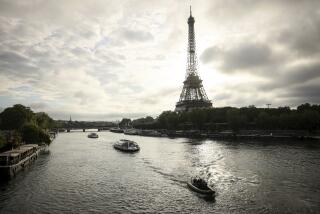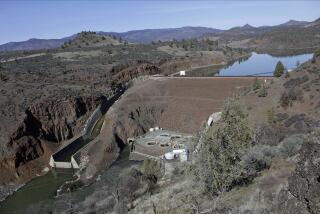REGIONAL REPORT : River Cleanups Bring Torrent of Investments : Chicago sets trend. Midwest cities put marinas, public areas along ex-eyesores.
- Share via
CHICAGO — A century ago, the open-air sewer that was the Chicago River contributed to the city having one of the nation’s highest cholera and typhoid rates. The river carried sewage into Lake Michigan where the city’s water intake pipes were located.
To solve the problem, the city launched a monumental undertaking. It excavated 41 million cubic feet of soil and rock at the turn of the century to reverse the river’s flow. Since then, measures have been taken to clean up the river, and now the waterway is one of Chicago’s biggest assets.
Though less dramatic, the same pattern of change has taken place throughout the Midwest, as the working rivers of formerly working-class towns are being transformed. Thanks to the environmental movement, urban rivers and waterways that once were ecological and health hazards as well as eyesores have been cleaned up.
Parks and plazas are being created along their banks, riverboat casinos are being launched and major real estate developments have been built or are being planned in cities such as Chicago, St. Louis, Cincinnati, Cleveland, Milwaukee, Minneapolis and Louisville.
Even smaller cities such as Alton, Ill., and Evanston, Ind., are getting into the act with marinas and public areas designed to capitalize on long neglected resources.
In downtown Chicago today, areas near the Chicago River are among the most sought-after by developers. On the river’s edge are new office buildings--structures that don’t turn their backs on the river but embrace it in their designs--and mixed-use projects such as the 50-acre Cityfront Center, which includes Chicago’s new NBC Tower, apartment buildings, restaurants, boutiques and parks.
The dramatic turnaround began in the late 1980s, almost 100 years after the city began the eight-year task of reversing the river’s flow in 1892. After that, sewage continued to pollute the river, only now it flowed away from Lake Michigan; instead of contaminating the city’s drinking water supply, it moved through canals and a succession of other rivers toward the Gulf of Mexico.
The Chicago River became significantly cleaner only after the first phase of the Metropolitan Sanitary District’s so-called Deep Tunnel project was completed in 1985 at a cost of $1.4 billion. The project is a still-unfinished system of tunnels and underground reservoirs that capture the city’s sewage and pump it to a treatment plant where it is purified before being released.
River cleanups in other cities have been similarly dramatic. In Cleveland, the Cuyahoga River, which snakes through downtown, was so polluted with oil and chemicals that in 1969 it caught on fire. Now the sooty factories and warehouses that once sat on its banks have been replaced by a bustling entertainment district called the Flats, which features 30 trendy nightclubs and restaurants.
In St. Louis, a nine-block area of warehouses on the northern edge of downtown--not far from the Gateway Arch--has been transformed into Laclede’s Landing, a cobble-stoned district of restaurants and nightclubs along the Mississippi that caters to conventioneers and suburbanites.
In Louisville, $13 million was raised from private sources to reclaim land along the Ohio River and to pay for part of the planning to convert a crumbling wharf and desolate levee into an entertainment district with riverboats, a park, a restaurant and a bar.
Many of these rivers still are used for barge traffic or for other commercial uses. They have also become, or are becoming, prime destinations for tourists and fun seekers.
And--thanks to new environmental awareness--developers who build on now-in-demand waterfronts will be obliged to help keep them clean.
More to Read
Sign up for Essential California
The most important California stories and recommendations in your inbox every morning.
You may occasionally receive promotional content from the Los Angeles Times.













